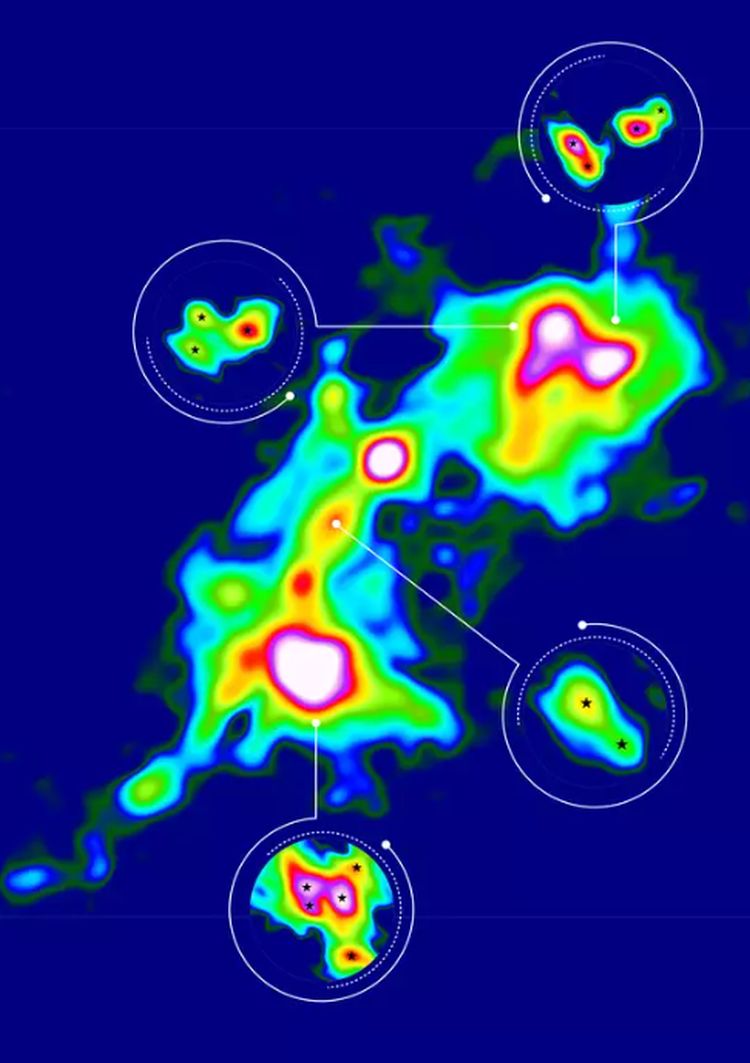All stars form in giant molecular clouds of hydrogen. But some stars are extraordinarily massive; the most massive one we know of is about 200 times more massive than the Sun. How do these stars gain so much mass?
Part of the answer is that they form in multiple star systems.
Astronomers have thought for a long time that massive stars are born in multiple stellar systems. They form as twins, triplets, quadruplets, or even larger sibling groups. Massive stars, defined as stars with more than eight stellar masses, are the progenitors of supernovae, neutron stars, and black holes. That’s why researchers are so keen on understanding their origins.
Astrophysicists have a strong theoretical knowledge of how stars form, and they’ve constructed detailed simulations of stellar formation. Those simulations show how massive stars form in a hierarchical process. Giant clouds collapse to form dense cores. In those “parent cores,” smaller regions collapse into individual stars: some massive and some not so massive. Astronomers think that our Sun formed as one of the less massive stars in this hierarchical process. They’ve even tracked down the Sun’s siblings.
Developing strong theories that describe Nature is a critical part of astronomy. But scientists have a healthy caution for something that remains theoretical. It takes observations to show how well theories match reality, and observations of multiple stars forming are difficult to obtain.
“Finally, we were able to take a detailed look at the rich array of multiple star systems in a massive star formation region!”
Henrik Beuther, researcher, Max Planck Institute for Astronomy
Now, a group of researchers using the Atacama Large Millimetre/submillimetre Array (ALMA) have gathered observations of several groupings of massive stars forming together. Their results are in the research article “Observations of high-order multiplicity in a high-mass stellar protocluster,” published in Nature Astronomy. The lead author is Shanghuo Li from the Max Planck Institute for Astronomy (MPIA.)
These results were years in the making. The ALMA observations took place between 2016 and 2019, and the data was so challenging that it also took several years to process. But the observations are filling in an important gap in our understanding of massive star formation.

“The dominant mechanism forming multiple stellar systems in the high-mass regime remained unknown because direct imaging of multiple protostellar systems at early phases of high-mass star formation is very challenging,” the authors write in their article. “So far, only a few high-mass protobinary systems, and no definitive higher-order multiples, have been detected.”
But these ALMA results change that.
The work centers on a massive star-forming region called G333.23–0.06. In it, the team of researchers found four binary proto-stars, one triple, one quadruple and one quintuple system.
“Finally, we were able to take a detailed look at the rich array of multiple star systems in a massive star formation region!” said co-author Henrik Beuther from the MPIA. “Particularly exciting is that the observations go as far as to provide evidence for a specific scenario for high-mass star formation.” The observations support the idea that massive stars form in a hierarchical manner.

The images support the theory of hierarchical massive star formation, but they don’t answer every scientific question about how massive stars form. “Our observations seem to indicate that when the cloud collapses, the multiples form very early on,” said lead author Li. “But is that really the case? Analyses of additional star formation regions, some of them younger than G333.23–0.06, should give us the answer.”
The researchers are already working on that analysis. They’ve observed a further 29 massive star formations with ALMA, and soon there’ll be 20 more of them to analyze. Those observations will further inform our understanding of massive, multiple-star formation. There are still many unanswered questions about how they form and evolve.
One of the questions concerns fragmentation. There could be two types of fragmentation at work in the formation of these multiple massive stars. One is disk fragmentation, and the other is core fragmentation. Overall, core fragmentation explains most of the multiple massive stars. But disk fragmentation could play a role, especially in binary systems. More research is needed to resolve this.
“Overall, these results demonstrate that the majority of detected multiple systems are formed from core fragmentation, although disk fragmentation may still occur on smaller scales than those we can resolve with the current spatial resolution,” the researchers explain.
Even though there are questions about how this all plays out, this research has attached observations to theory, a critical step in understanding how massive stars form.
“The discovery of these quintuple, quadruple, triple and binary protostellar systems is the best observational evidence to show the imprints of core fragmentation in building multiplicity in high-mass cluster-forming environments,” the researchers write in their article.
There are more regions like G333 out there, and studying them will give us an even more detailed understanding of how these high-mass stars form and evolve. “Their properties will determine the initial conditions of multiple system formation, as well as the dynamical evolution in a cluster environment,” the authors conclude.

